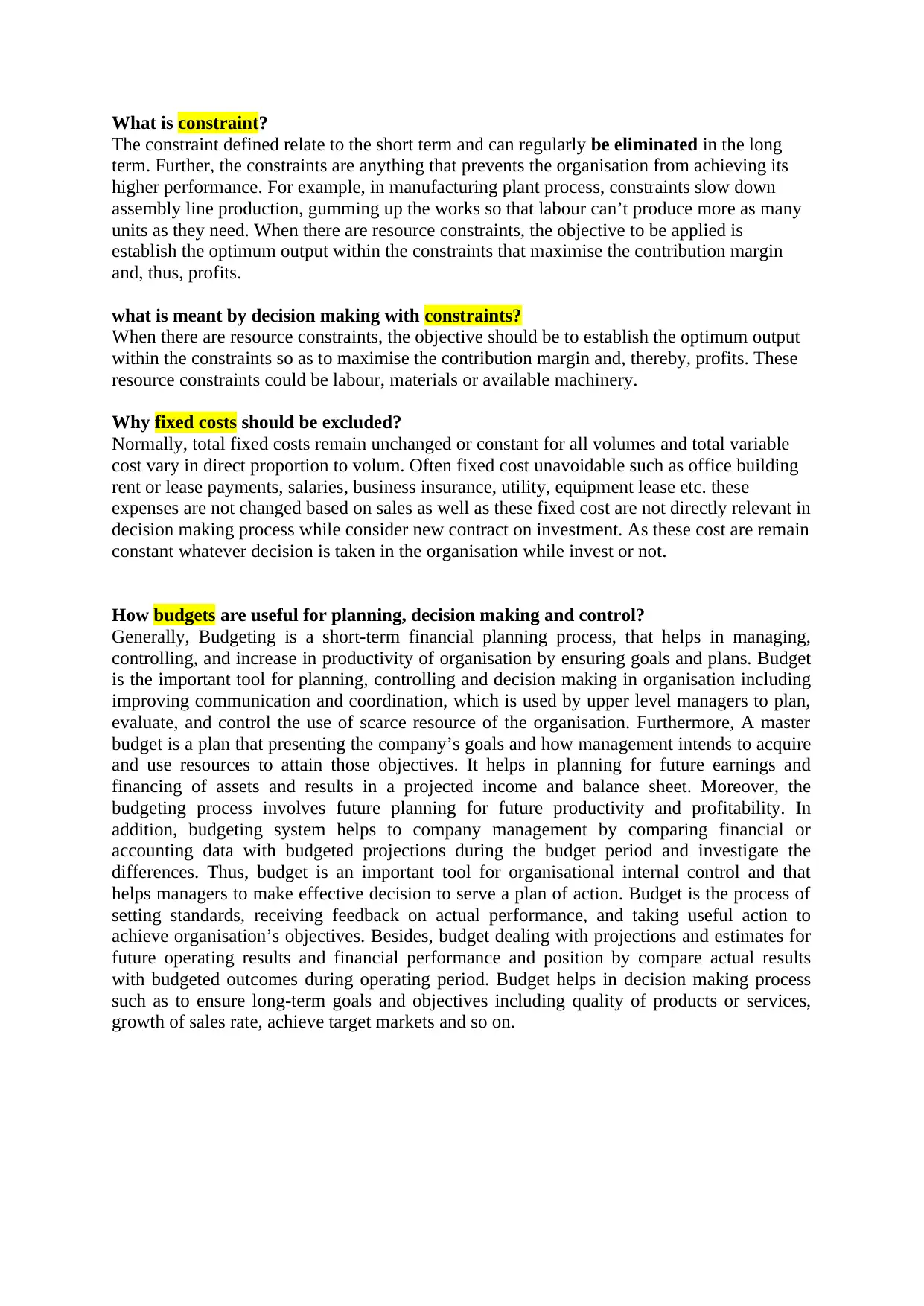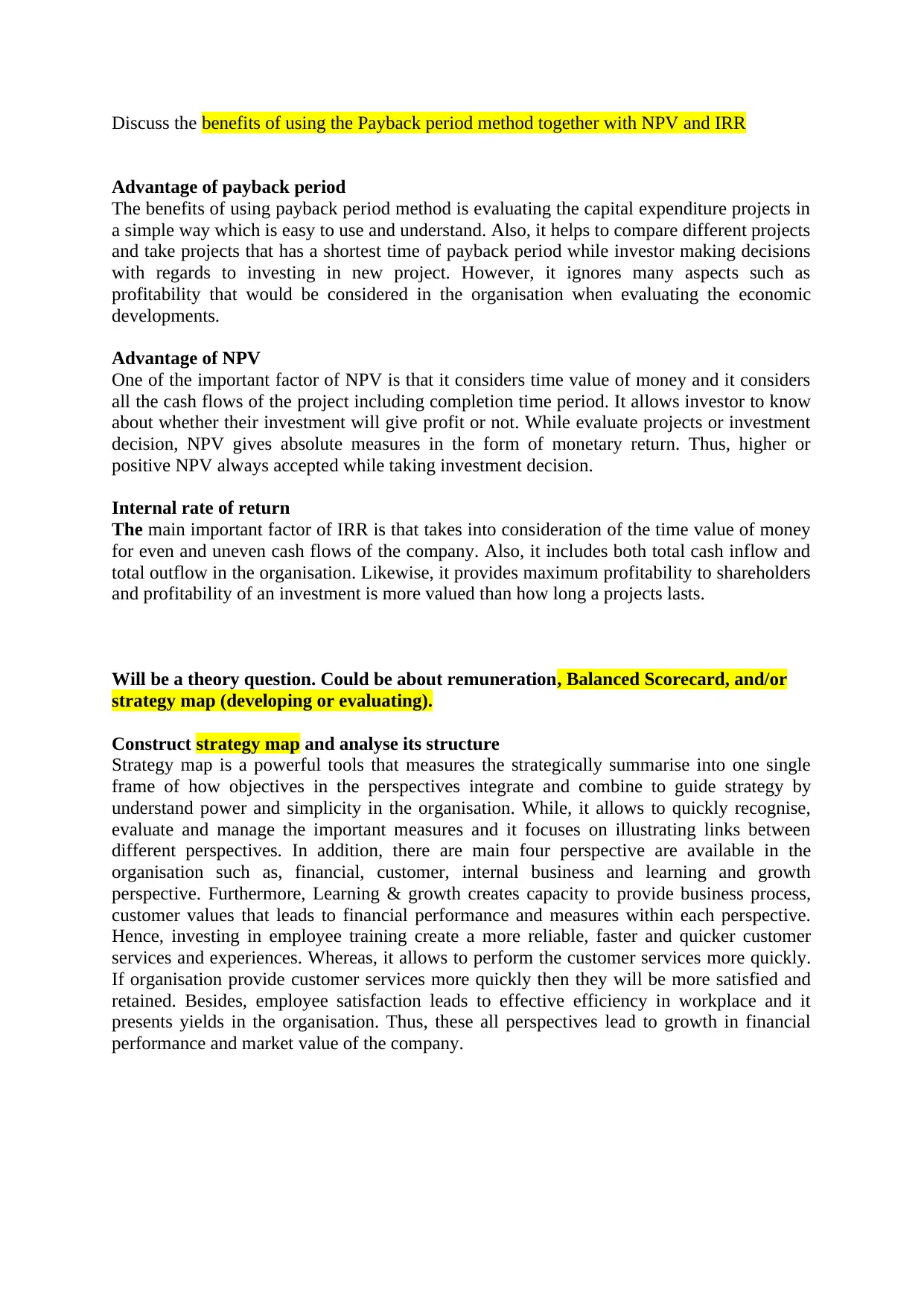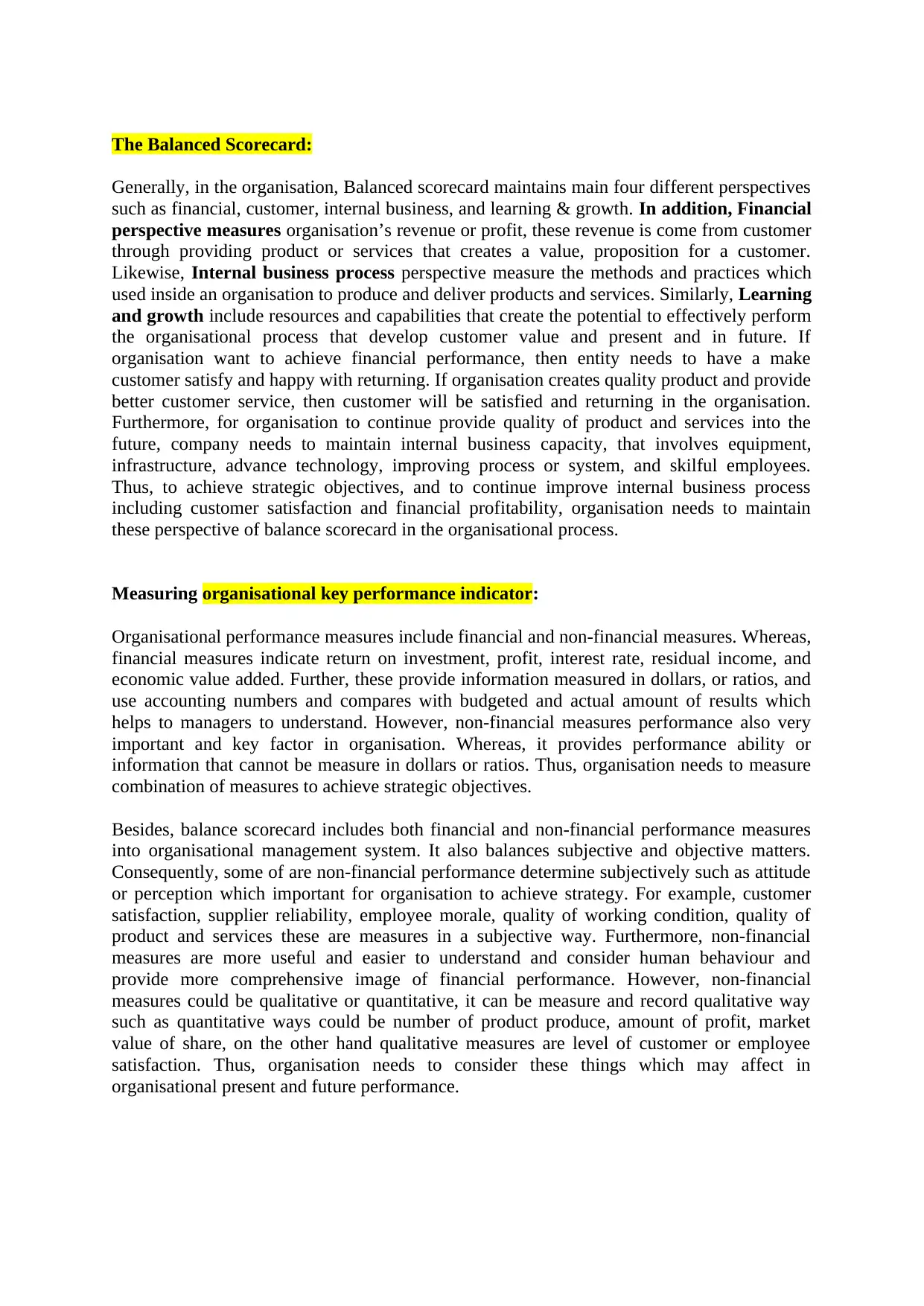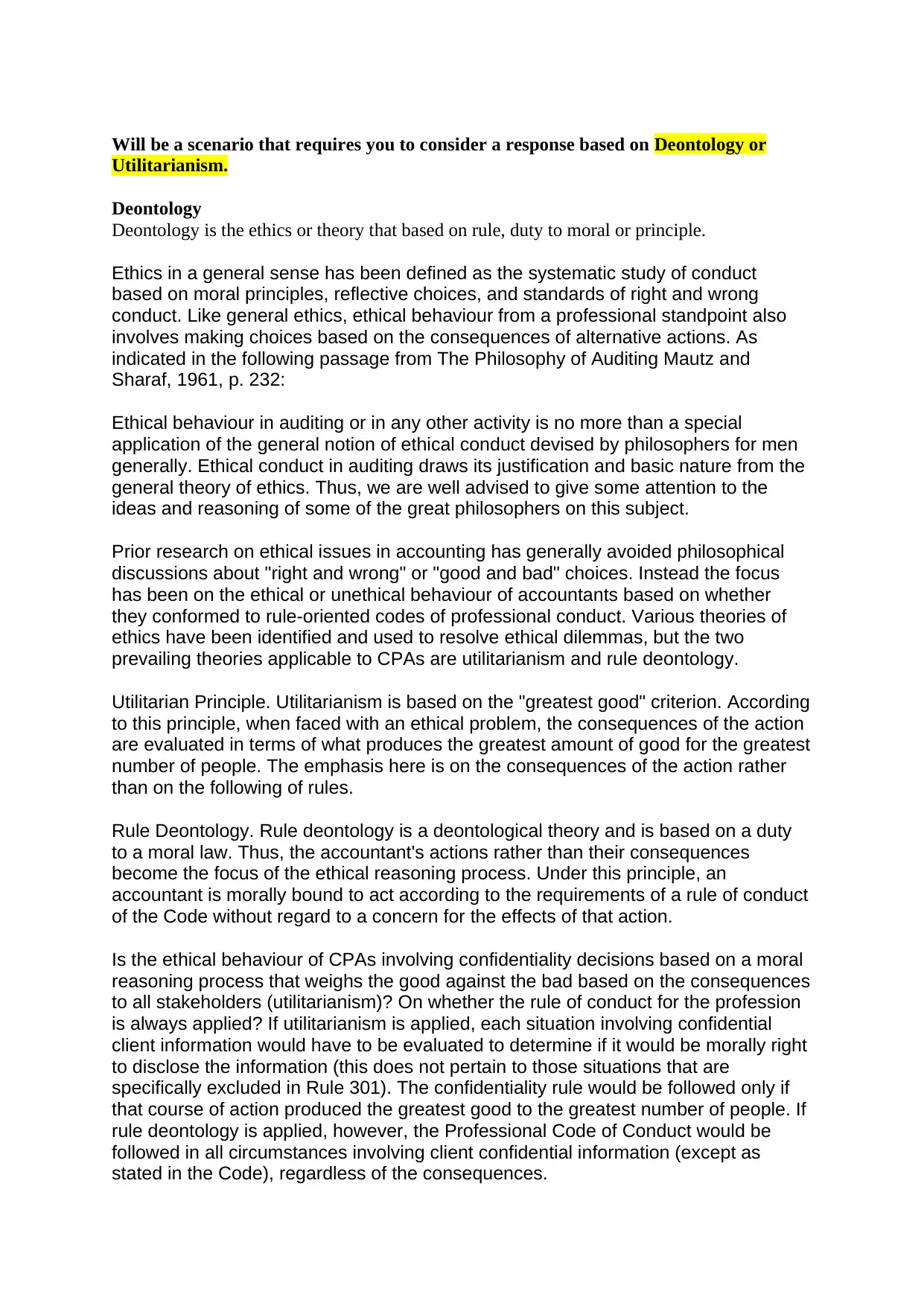Analysis of Constraints, Budgeting, and Ethical Practices
VerifiedAdded on 2020/11/02
|4
|2087
|46
Homework Assignment
AI Summary
This assignment delves into various aspects of business development, beginning with the concept of constraints and how they impact organizational performance, particularly in manufacturing and resource allocation. It then explores the importance of budgeting for planning, decision-making, and control, including the use of master budgets. The assignment also examines the payback period, NPV, and IRR methods for evaluating capital expenditure projects, highlighting their advantages. Furthermore, it covers the construction and analysis of a strategy map, as well as the Balanced Scorecard, and the measurement of key performance indicators. Finally, the assignment discusses ethical decision-making frameworks, specifically deontology and utilitarianism, providing a comprehensive overview of business management principles and practices.

What is constraint?
The constraint defined relate to the short term and can regularly be eliminated in the long
term. Further, the constraints are anything that prevents the organisation from achieving its
higher performance. For example, in manufacturing plant process, constraints slow down
assembly line production, gumming up the works so that labour can’t produce more as many
units as they need. When there are resource constraints, the objective to be applied is
establish the optimum output within the constraints that maximise the contribution margin
and, thus, profits.
what is meant by decision making with constraints?
When there are resource constraints, the objective should be to establish the optimum output
within the constraints so as to maximise the contribution margin and, thereby, profits. These
resource constraints could be labour, materials or available machinery.
Why fixed costs should be excluded?
Normally, total fixed costs remain unchanged or constant for all volumes and total variable
cost vary in direct proportion to volum. Often fixed cost unavoidable such as office building
rent or lease payments, salaries, business insurance, utility, equipment lease etc. these
expenses are not changed based on sales as well as these fixed cost are not directly relevant in
decision making process while consider new contract on investment. As these cost are remain
constant whatever decision is taken in the organisation while invest or not.
How budgets are useful for planning, decision making and control?
Generally, Budgeting is a short-term financial planning process, that helps in managing,
controlling, and increase in productivity of organisation by ensuring goals and plans. Budget
is the important tool for planning, controlling and decision making in organisation including
improving communication and coordination, which is used by upper level managers to plan,
evaluate, and control the use of scarce resource of the organisation. Furthermore, A master
budget is a plan that presenting the company’s goals and how management intends to acquire
and use resources to attain those objectives. It helps in planning for future earnings and
financing of assets and results in a projected income and balance sheet. Moreover, the
budgeting process involves future planning for future productivity and profitability. In
addition, budgeting system helps to company management by comparing financial or
accounting data with budgeted projections during the budget period and investigate the
differences. Thus, budget is an important tool for organisational internal control and that
helps managers to make effective decision to serve a plan of action. Budget is the process of
setting standards, receiving feedback on actual performance, and taking useful action to
achieve organisation’s objectives. Besides, budget dealing with projections and estimates for
future operating results and financial performance and position by compare actual results
with budgeted outcomes during operating period. Budget helps in decision making process
such as to ensure long-term goals and objectives including quality of products or services,
growth of sales rate, achieve target markets and so on.
The constraint defined relate to the short term and can regularly be eliminated in the long
term. Further, the constraints are anything that prevents the organisation from achieving its
higher performance. For example, in manufacturing plant process, constraints slow down
assembly line production, gumming up the works so that labour can’t produce more as many
units as they need. When there are resource constraints, the objective to be applied is
establish the optimum output within the constraints that maximise the contribution margin
and, thus, profits.
what is meant by decision making with constraints?
When there are resource constraints, the objective should be to establish the optimum output
within the constraints so as to maximise the contribution margin and, thereby, profits. These
resource constraints could be labour, materials or available machinery.
Why fixed costs should be excluded?
Normally, total fixed costs remain unchanged or constant for all volumes and total variable
cost vary in direct proportion to volum. Often fixed cost unavoidable such as office building
rent or lease payments, salaries, business insurance, utility, equipment lease etc. these
expenses are not changed based on sales as well as these fixed cost are not directly relevant in
decision making process while consider new contract on investment. As these cost are remain
constant whatever decision is taken in the organisation while invest or not.
How budgets are useful for planning, decision making and control?
Generally, Budgeting is a short-term financial planning process, that helps in managing,
controlling, and increase in productivity of organisation by ensuring goals and plans. Budget
is the important tool for planning, controlling and decision making in organisation including
improving communication and coordination, which is used by upper level managers to plan,
evaluate, and control the use of scarce resource of the organisation. Furthermore, A master
budget is a plan that presenting the company’s goals and how management intends to acquire
and use resources to attain those objectives. It helps in planning for future earnings and
financing of assets and results in a projected income and balance sheet. Moreover, the
budgeting process involves future planning for future productivity and profitability. In
addition, budgeting system helps to company management by comparing financial or
accounting data with budgeted projections during the budget period and investigate the
differences. Thus, budget is an important tool for organisational internal control and that
helps managers to make effective decision to serve a plan of action. Budget is the process of
setting standards, receiving feedback on actual performance, and taking useful action to
achieve organisation’s objectives. Besides, budget dealing with projections and estimates for
future operating results and financial performance and position by compare actual results
with budgeted outcomes during operating period. Budget helps in decision making process
such as to ensure long-term goals and objectives including quality of products or services,
growth of sales rate, achieve target markets and so on.
Paraphrase This Document
Need a fresh take? Get an instant paraphrase of this document with our AI Paraphraser

Discuss the benefits of using the Payback period method together with NPV and IRR
Advantage of payback period
The benefits of using payback period method is evaluating the capital expenditure projects in
a simple way which is easy to use and understand. Also, it helps to compare different projects
and take projects that has a shortest time of payback period while investor making decisions
with regards to investing in new project. However, it ignores many aspects such as
profitability that would be considered in the organisation when evaluating the economic
developments.
Advantage of NPV
One of the important factor of NPV is that it considers time value of money and it considers
all the cash flows of the project including completion time period. It allows investor to know
about whether their investment will give profit or not. While evaluate projects or investment
decision, NPV gives absolute measures in the form of monetary return. Thus, higher or
positive NPV always accepted while taking investment decision.
Internal rate of return
The main important factor of IRR is that takes into consideration of the time value of money
for even and uneven cash flows of the company. Also, it includes both total cash inflow and
total outflow in the organisation. Likewise, it provides maximum profitability to shareholders
and profitability of an investment is more valued than how long a projects lasts.
Will be a theory question. Could be about remuneration, Balanced Scorecard, and/or
strategy map (developing or evaluating).
Construct strategy map and analyse its structure
Strategy map is a powerful tools that measures the strategically summarise into one single
frame of how objectives in the perspectives integrate and combine to guide strategy by
understand power and simplicity in the organisation. While, it allows to quickly recognise,
evaluate and manage the important measures and it focuses on illustrating links between
different perspectives. In addition, there are main four perspective are available in the
organisation such as, financial, customer, internal business and learning and growth
perspective. Furthermore, Learning & growth creates capacity to provide business process,
customer values that leads to financial performance and measures within each perspective.
Hence, investing in employee training create a more reliable, faster and quicker customer
services and experiences. Whereas, it allows to perform the customer services more quickly.
If organisation provide customer services more quickly then they will be more satisfied and
retained. Besides, employee satisfaction leads to effective efficiency in workplace and it
presents yields in the organisation. Thus, these all perspectives lead to growth in financial
performance and market value of the company.
Advantage of payback period
The benefits of using payback period method is evaluating the capital expenditure projects in
a simple way which is easy to use and understand. Also, it helps to compare different projects
and take projects that has a shortest time of payback period while investor making decisions
with regards to investing in new project. However, it ignores many aspects such as
profitability that would be considered in the organisation when evaluating the economic
developments.
Advantage of NPV
One of the important factor of NPV is that it considers time value of money and it considers
all the cash flows of the project including completion time period. It allows investor to know
about whether their investment will give profit or not. While evaluate projects or investment
decision, NPV gives absolute measures in the form of monetary return. Thus, higher or
positive NPV always accepted while taking investment decision.
Internal rate of return
The main important factor of IRR is that takes into consideration of the time value of money
for even and uneven cash flows of the company. Also, it includes both total cash inflow and
total outflow in the organisation. Likewise, it provides maximum profitability to shareholders
and profitability of an investment is more valued than how long a projects lasts.
Will be a theory question. Could be about remuneration, Balanced Scorecard, and/or
strategy map (developing or evaluating).
Construct strategy map and analyse its structure
Strategy map is a powerful tools that measures the strategically summarise into one single
frame of how objectives in the perspectives integrate and combine to guide strategy by
understand power and simplicity in the organisation. While, it allows to quickly recognise,
evaluate and manage the important measures and it focuses on illustrating links between
different perspectives. In addition, there are main four perspective are available in the
organisation such as, financial, customer, internal business and learning and growth
perspective. Furthermore, Learning & growth creates capacity to provide business process,
customer values that leads to financial performance and measures within each perspective.
Hence, investing in employee training create a more reliable, faster and quicker customer
services and experiences. Whereas, it allows to perform the customer services more quickly.
If organisation provide customer services more quickly then they will be more satisfied and
retained. Besides, employee satisfaction leads to effective efficiency in workplace and it
presents yields in the organisation. Thus, these all perspectives lead to growth in financial
performance and market value of the company.

The Balanced Scorecard:
Generally, in the organisation, Balanced scorecard maintains main four different perspectives
such as financial, customer, internal business, and learning & growth. In addition, Financial
perspective measures organisation’s revenue or profit, these revenue is come from customer
through providing product or services that creates a value, proposition for a customer.
Likewise, Internal business process perspective measure the methods and practices which
used inside an organisation to produce and deliver products and services. Similarly, Learning
and growth include resources and capabilities that create the potential to effectively perform
the organisational process that develop customer value and present and in future. If
organisation want to achieve financial performance, then entity needs to have a make
customer satisfy and happy with returning. If organisation creates quality product and provide
better customer service, then customer will be satisfied and returning in the organisation.
Furthermore, for organisation to continue provide quality of product and services into the
future, company needs to maintain internal business capacity, that involves equipment,
infrastructure, advance technology, improving process or system, and skilful employees.
Thus, to achieve strategic objectives, and to continue improve internal business process
including customer satisfaction and financial profitability, organisation needs to maintain
these perspective of balance scorecard in the organisational process.
Measuring organisational key performance indicator:
Organisational performance measures include financial and non-financial measures. Whereas,
financial measures indicate return on investment, profit, interest rate, residual income, and
economic value added. Further, these provide information measured in dollars, or ratios, and
use accounting numbers and compares with budgeted and actual amount of results which
helps to managers to understand. However, non-financial measures performance also very
important and key factor in organisation. Whereas, it provides performance ability or
information that cannot be measure in dollars or ratios. Thus, organisation needs to measure
combination of measures to achieve strategic objectives.
Besides, balance scorecard includes both financial and non-financial performance measures
into organisational management system. It also balances subjective and objective matters.
Consequently, some of are non-financial performance determine subjectively such as attitude
or perception which important for organisation to achieve strategy. For example, customer
satisfaction, supplier reliability, employee morale, quality of working condition, quality of
product and services these are measures in a subjective way. Furthermore, non-financial
measures are more useful and easier to understand and consider human behaviour and
provide more comprehensive image of financial performance. However, non-financial
measures could be qualitative or quantitative, it can be measure and record qualitative way
such as quantitative ways could be number of product produce, amount of profit, market
value of share, on the other hand qualitative measures are level of customer or employee
satisfaction. Thus, organisation needs to consider these things which may affect in
organisational present and future performance.
Generally, in the organisation, Balanced scorecard maintains main four different perspectives
such as financial, customer, internal business, and learning & growth. In addition, Financial
perspective measures organisation’s revenue or profit, these revenue is come from customer
through providing product or services that creates a value, proposition for a customer.
Likewise, Internal business process perspective measure the methods and practices which
used inside an organisation to produce and deliver products and services. Similarly, Learning
and growth include resources and capabilities that create the potential to effectively perform
the organisational process that develop customer value and present and in future. If
organisation want to achieve financial performance, then entity needs to have a make
customer satisfy and happy with returning. If organisation creates quality product and provide
better customer service, then customer will be satisfied and returning in the organisation.
Furthermore, for organisation to continue provide quality of product and services into the
future, company needs to maintain internal business capacity, that involves equipment,
infrastructure, advance technology, improving process or system, and skilful employees.
Thus, to achieve strategic objectives, and to continue improve internal business process
including customer satisfaction and financial profitability, organisation needs to maintain
these perspective of balance scorecard in the organisational process.
Measuring organisational key performance indicator:
Organisational performance measures include financial and non-financial measures. Whereas,
financial measures indicate return on investment, profit, interest rate, residual income, and
economic value added. Further, these provide information measured in dollars, or ratios, and
use accounting numbers and compares with budgeted and actual amount of results which
helps to managers to understand. However, non-financial measures performance also very
important and key factor in organisation. Whereas, it provides performance ability or
information that cannot be measure in dollars or ratios. Thus, organisation needs to measure
combination of measures to achieve strategic objectives.
Besides, balance scorecard includes both financial and non-financial performance measures
into organisational management system. It also balances subjective and objective matters.
Consequently, some of are non-financial performance determine subjectively such as attitude
or perception which important for organisation to achieve strategy. For example, customer
satisfaction, supplier reliability, employee morale, quality of working condition, quality of
product and services these are measures in a subjective way. Furthermore, non-financial
measures are more useful and easier to understand and consider human behaviour and
provide more comprehensive image of financial performance. However, non-financial
measures could be qualitative or quantitative, it can be measure and record qualitative way
such as quantitative ways could be number of product produce, amount of profit, market
value of share, on the other hand qualitative measures are level of customer or employee
satisfaction. Thus, organisation needs to consider these things which may affect in
organisational present and future performance.
⊘ This is a preview!⊘
Do you want full access?
Subscribe today to unlock all pages.

Trusted by 1+ million students worldwide

Will be a scenario that requires you to consider a response based on Deontology or
Utilitarianism.
Deontology
Deontology is the ethics or theory that based on rule, duty to moral or principle.
Ethics in a general sense has been defined as the systematic study of conduct
based on moral principles, reflective choices, and standards of right and wrong
conduct. Like general ethics, ethical behaviour from a professional standpoint also
involves making choices based on the consequences of alternative actions. As
indicated in the following passage from The Philosophy of Auditing Mautz and
Sharaf, 1961, p. 232:
Ethical behaviour in auditing or in any other activity is no more than a special
application of the general notion of ethical conduct devised by philosophers for men
generally. Ethical conduct in auditing draws its justification and basic nature from the
general theory of ethics. Thus, we are well advised to give some attention to the
ideas and reasoning of some of the great philosophers on this subject.
Prior research on ethical issues in accounting has generally avoided philosophical
discussions about "right and wrong" or "good and bad" choices. Instead the focus
has been on the ethical or unethical behaviour of accountants based on whether
they conformed to rule-oriented codes of professional conduct. Various theories of
ethics have been identified and used to resolve ethical dilemmas, but the two
prevailing theories applicable to CPAs are utilitarianism and rule deontology.
Utilitarian Principle. Utilitarianism is based on the "greatest good" criterion. According
to this principle, when faced with an ethical problem, the consequences of the action
are evaluated in terms of what produces the greatest amount of good for the greatest
number of people. The emphasis here is on the consequences of the action rather
than on the following of rules.
Rule Deontology. Rule deontology is a deontological theory and is based on a duty
to a moral law. Thus, the accountant's actions rather than their consequences
become the focus of the ethical reasoning process. Under this principle, an
accountant is morally bound to act according to the requirements of a rule of conduct
of the Code without regard to a concern for the effects of that action.
Is the ethical behaviour of CPAs involving confidentiality decisions based on a moral
reasoning process that weighs the good against the bad based on the consequences
to all stakeholders (utilitarianism)? On whether the rule of conduct for the profession
is always applied? If utilitarianism is applied, each situation involving confidential
client information would have to be evaluated to determine if it would be morally right
to disclose the information (this does not pertain to those situations that are
specifically excluded in Rule 301). The confidentiality rule would be followed only if
that course of action produced the greatest good to the greatest number of people. If
rule deontology is applied, however, the Professional Code of Conduct would be
followed in all circumstances involving client confidential information (except as
stated in the Code), regardless of the consequences.
Utilitarianism.
Deontology
Deontology is the ethics or theory that based on rule, duty to moral or principle.
Ethics in a general sense has been defined as the systematic study of conduct
based on moral principles, reflective choices, and standards of right and wrong
conduct. Like general ethics, ethical behaviour from a professional standpoint also
involves making choices based on the consequences of alternative actions. As
indicated in the following passage from The Philosophy of Auditing Mautz and
Sharaf, 1961, p. 232:
Ethical behaviour in auditing or in any other activity is no more than a special
application of the general notion of ethical conduct devised by philosophers for men
generally. Ethical conduct in auditing draws its justification and basic nature from the
general theory of ethics. Thus, we are well advised to give some attention to the
ideas and reasoning of some of the great philosophers on this subject.
Prior research on ethical issues in accounting has generally avoided philosophical
discussions about "right and wrong" or "good and bad" choices. Instead the focus
has been on the ethical or unethical behaviour of accountants based on whether
they conformed to rule-oriented codes of professional conduct. Various theories of
ethics have been identified and used to resolve ethical dilemmas, but the two
prevailing theories applicable to CPAs are utilitarianism and rule deontology.
Utilitarian Principle. Utilitarianism is based on the "greatest good" criterion. According
to this principle, when faced with an ethical problem, the consequences of the action
are evaluated in terms of what produces the greatest amount of good for the greatest
number of people. The emphasis here is on the consequences of the action rather
than on the following of rules.
Rule Deontology. Rule deontology is a deontological theory and is based on a duty
to a moral law. Thus, the accountant's actions rather than their consequences
become the focus of the ethical reasoning process. Under this principle, an
accountant is morally bound to act according to the requirements of a rule of conduct
of the Code without regard to a concern for the effects of that action.
Is the ethical behaviour of CPAs involving confidentiality decisions based on a moral
reasoning process that weighs the good against the bad based on the consequences
to all stakeholders (utilitarianism)? On whether the rule of conduct for the profession
is always applied? If utilitarianism is applied, each situation involving confidential
client information would have to be evaluated to determine if it would be morally right
to disclose the information (this does not pertain to those situations that are
specifically excluded in Rule 301). The confidentiality rule would be followed only if
that course of action produced the greatest good to the greatest number of people. If
rule deontology is applied, however, the Professional Code of Conduct would be
followed in all circumstances involving client confidential information (except as
stated in the Code), regardless of the consequences.
1 out of 4
Related Documents
Your All-in-One AI-Powered Toolkit for Academic Success.
+13062052269
info@desklib.com
Available 24*7 on WhatsApp / Email
![[object Object]](/_next/static/media/star-bottom.7253800d.svg)
Unlock your academic potential
Copyright © 2020–2025 A2Z Services. All Rights Reserved. Developed and managed by ZUCOL.





